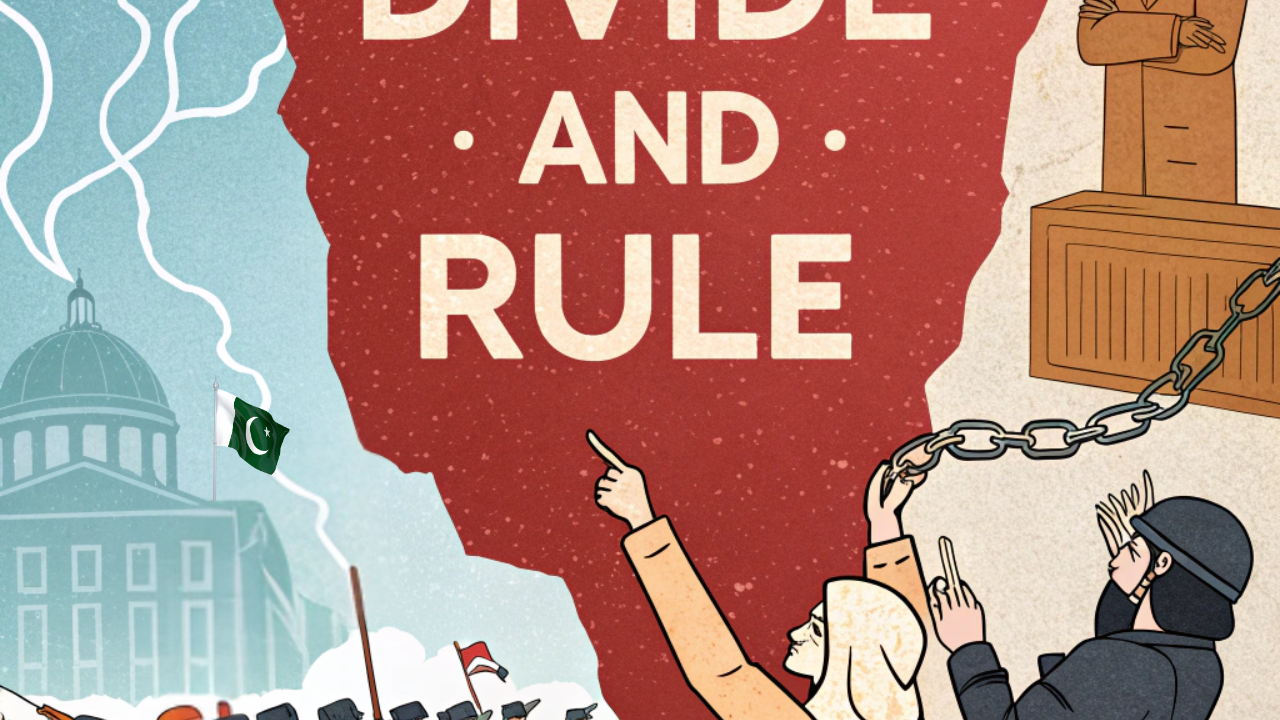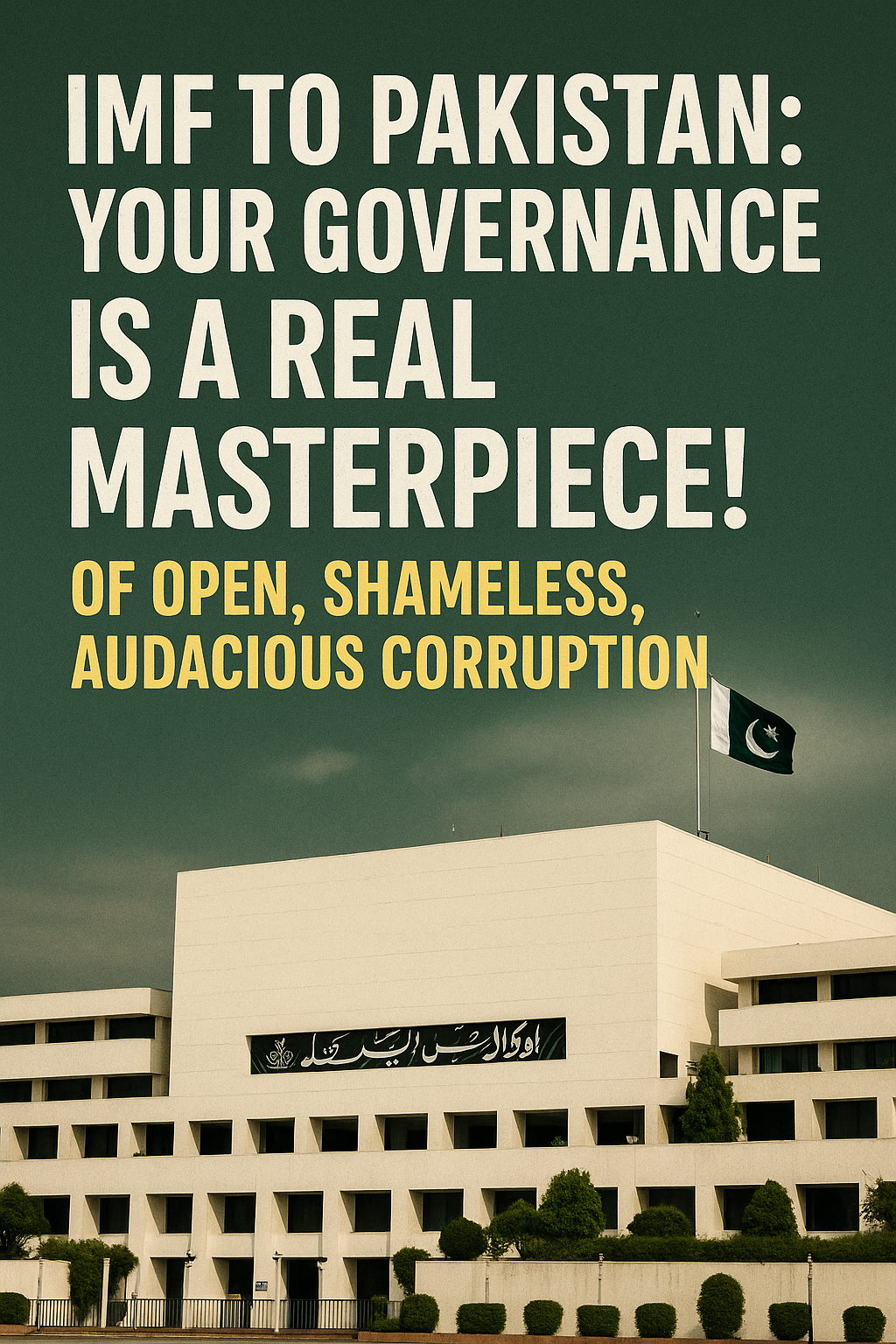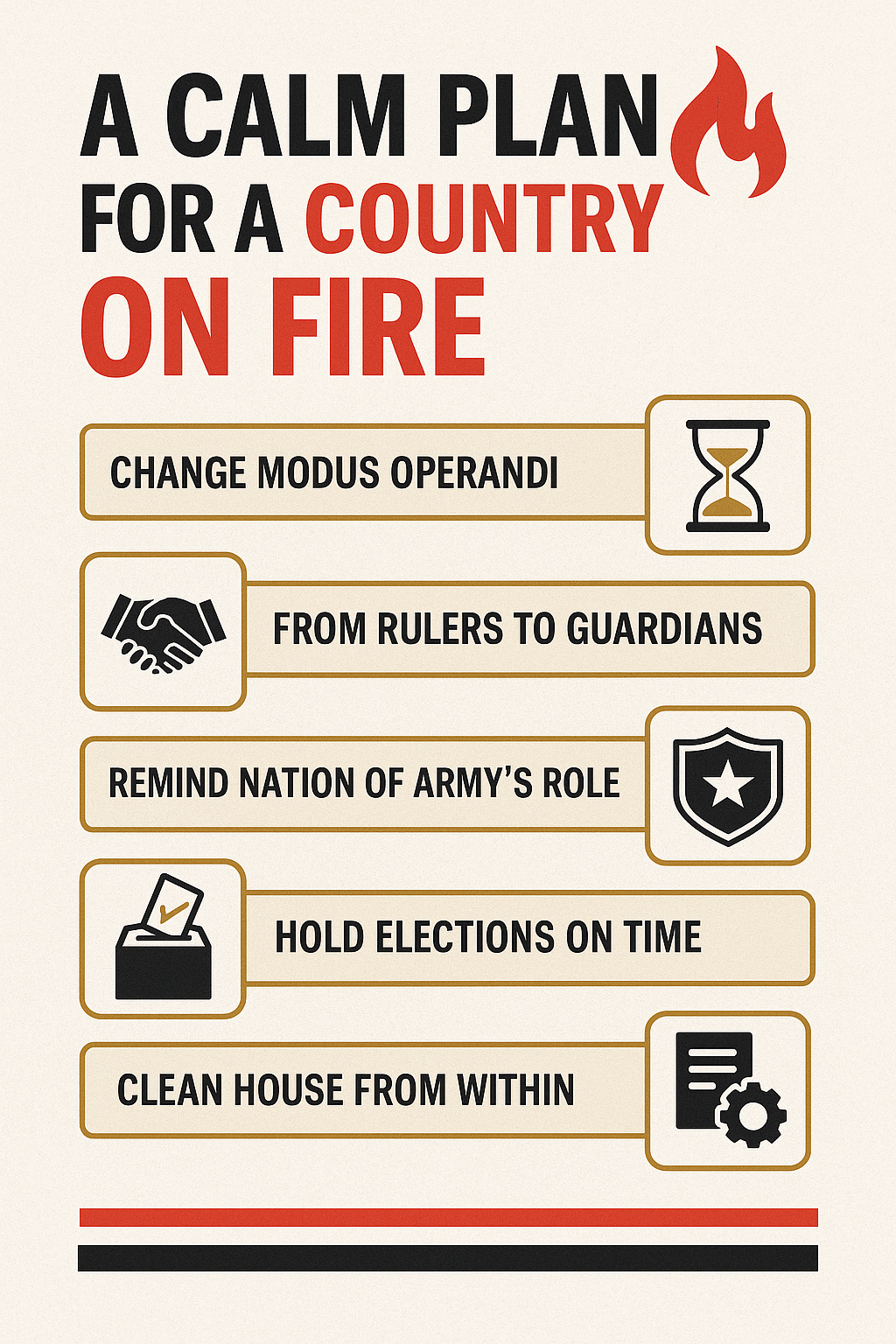The strategies of “divide and rule” playbook described in my previous blog are not just theoretical—they are being executed with chilling precision in Pakistan today. Over the past decades, Pakistan’s ruling elite and military establishment have carefully and systematically adopted tactics to weaken political opposition, restrict civil liberties, and keep the population divided and struggling. The goal is clear: to consolidate power by ensuring that the people remain too distracted, fearful, and economically burdened to challenge the regime.
In this blog, I will demonstrate how Pakistan is following the exact same strategies outlined in the “divide and rule” playbook, step by step. Real events and patterns of state behavior show that the Pakistani regime is working to establish a fascist state by promoting division, limiting freedoms, manipulating the judiciary, and controlling critical institutions. The goal is not just to maintain political dominance—it’s to create a population that is too fragmented and economically dependent to resist.
The Strategy of Division
Just like in classic fascist states, the Pakistani regime is intentionally exploiting social, religious, and political divisions to keep the population fragmented and unable to organize against the state.
1. Creating Fear and Distrust
The Pakistani state has mastered the art of manufacturing fear to control the population. The rise of religious extremism and terrorism—often with the tacit or direct support of the state—has been used to justify harsh security measures and political crackdowns. Rather than fighting it, which is their only job, they are the ones who are promoting it.
- The military establishment has a long history of supporting extremist groups like the Taliban and Lashkar-e-Taiba, which are then used as tools to stoke fear and insecurity.
- Any political opposition is quickly labeled as “foreign agents” or “enemies of Islam.” Leaders of opposition parties are accused of working with India or the West to destabilize the country.
- The rise of enforced disappearances—where activists, journalists, and political opponents are abducted by security forces—has created an atmosphere of terror, where people are afraid to speak out.
The result is a society where neighbors distrust each other, political activism is suppressed, and the state presents itself as the only force capable of maintaining order.
2. Promoting Identity Politics
Pakistan’s political elite has long exploited religious and ethnic identity to divide the population. Rather than fostering national unity, the regime has weaponized identity to create division and conflict.
- Sunni-Shia tensions have been actively stoked by state policies and propaganda. Minority sects like the Shia and Ahmadi communities are frequently targeted by blasphemy laws and mob violence, which the state does little to prevent.
- The Baloch and Pashtun communities face systemic discrimination and state violence. The rise of the Pashtun Tahafuz Movement (PTM), the Baloch Yakjehti Committee (BYC) under the leadership of figures like Mahrang Baloch and Baluch Liberation Army (BLA) are direct responses to state-sponsored persecution and military operations in tribal areas and Balochistan. Mahrang Baloch has emerged as a powerful voice against enforced disappearances, military aggression, and the exploitation of Baloch resources, despite facing threats and state repression.
- General Zia-ul-Haq created Muhajir Qaumi Movement (MQM) in the 1980’s to counter the influence of the Pakistan Peoples Party (PPP). By fostering ethnic division and creating a political rival, the regime effectively weakened the PPP’s political dominance and ensured that opposition to military-backed rule remained fragmented.
- Politicians and military-backed media regularly blame “outsiders” (India, Afghanistan, the US) for Pakistan’s economic and security problems to deflect attention from government failures.
By creating internal conflict based on religion and ethnicity, the regime ensures that people remain divided and hostile toward each other, rather than toward the ruling elite.
3. Encouraging Sectarian Conflict
Sectarian violence in Pakistan is not just the product of religious extremism—it’s the outcome of deliberate state policy.
- The state has provided political and financial support to Sunni extremist groups like Sipah-e-Sahaba and Lashkar-e-Jhangvi, which have carried out deadly attacks on Shia communities.
- The emergence of Tehreek-e-Labbaik Pakistan (TLP) reflects the state’s strategy of manipulating religious sentiments to maintain control. By allowing or tacitly supporting such groups, the regime fosters an environment where religious extremism can be used to suppress dissent and justify authoritarian measures. This tactic aligns with the broader “divide and rule” approach, keeping the populace divided and distracted from pressing socio-political issues.
- The military establishment has used proxy groups in Kashmir and Afghanistan to promote jihadist ideology, while allowing these same groups to target minorities at home.
- The state has even manipulated local elections by supporting extremist religious parties to weaken secular political opposition.
The goal is to maintain a constant level of sectarian conflict to justify the expansion of state power and keep the population fearful and divided.
Suppressing Basic Rights Through Division
The Pakistani regime has implemented a systematic program to restrict political freedom, manipulate the judiciary, limit access to education, and undermine economic independence. These strategies are designed to weaken civil society and make the population dependent on the state.
1. Denial of Political Freedom
Freedom of speech, political assembly, and independent journalism are under constant assault in Pakistan.
- All mainstream media channels are facing government censorship, with fines, shutdowns, and heavy restrictions imposed for airing any criticism of the military and political leadership. Only state-approved narratives are allowed to reach the public, ensuring that independent voices are silenced and the population remains uninformed and misled.
- Political opposition leaders like Nawaz Sharif and Shehbaz Sharif have been arrested in the past, and currently Imran Khan is in jail on fabricated charges. Meanwhile, leaders like Shehbaz Sharif, Maryam Nawaz and Bilawal Bhutto, who are part of the state-installed government, remain safe and untouched despite clear political controversies.
- Internet blackouts and social media bans have been used to prevent political mobilization and communication among activists. The PECA Act (Prevention of Electronic Crimes Act) has now been enacted through the sham parliament to provide a legal cover for these actions, giving the state broad powers to monitor, censor, and punish online activity under the guise of maintaining ‘national security.’ This law effectively criminalizes dissent and further restricts freedom of speech in the digital space, making it easier for the regime to control the narrative and silence opposition.
The message is clear: Political opposition will not be tolerated, and the State will control the narrative.
2. Politicization of the Judiciary
The Pakistani judiciary has been systematically corrupted and politicized to serve the interests of the ruling elite. Case in point: Justice Faiz Isa, who will go down in history as the most controversial and disliked Chief Justice in Pakistan’s judicial history. His rulings and conduct have raised serious questions about the independence and credibility of the judiciary, reinforcing the perception that the courts are extensions of the ruling elite’s political agenda.
- Judges who rule against the military or the political establishment are quickly sidelined or removed from office.
- The Supreme Court’s disqualification of Prime Minister Nawaz Sharif in 2017 on corruption charges has now been overturned and whitewashed because he currently aligns himself with the fascist regime. This blatant reversal highlights how the judiciary has become a political tool rather than an impartial institution of justice.
- Judges who refuse to align with the state’s political interests face public smears, intimidation, and removal from their posts.
- Imran Khan has been in jail for the last one and a half years on fabricated charges. All unethical actions are being taken to keep him in jail because the regime fears his massive popularity and the political threat he poses. His ability to mobilize millions of supporters across Pakistan makes him the single biggest threat to the current fascist order.
By controlling the judiciary through the sham 26th amendment of the constitution, passed by forced voting in the state-installed assembly following the rigged 2024 national elections, the regime has eliminated any independent check on its power and ensured that political rivals face legal harassment and imprisonment.
3. Control Over Education
Education in Pakistan has been systematically undermined to prevent the rise of critical thinking and political awareness.
- School textbooks have been revised to promote Islamic nationalism and historical revisionism, glorifying military rulers and jihadist ideologies.
- Universities that have allowed political activism or critical discourse have faced budget cuts, administrative pressure, and surveillance.
- The state has promoted religious seminaries (madrassas) over secular schools, ensuring that large segments of the population receive religious indoctrination rather than modern education.
An uneducated population is easier to control and less likely to challenge state narratives.
4. Undermining Economic Independence
Economic instability is a deliberate tool of control in Pakistan.
- High inflation, lack of job creation, and wealth concentration in the hands of a corrupt elite have kept most Pakistanis in a state of financial insecurity.
- Government subsidies and welfare programs are handed out based on political loyalty, reinforcing dependence on the state.
- Military-owned business empires like Fauji Foundation, Defense Housing and Bahria Town control vast sectors of the economy, limiting opportunities for independent entrepreneurship.
- Internet blackouts and slowdowns have severely impacted internet-based businesses and freelancers, limiting their ability to operate and earn a stable income, further increasing economic dependence on the state.
A struggling population is more likely to look to the state for support, reinforcing the regime’s control.
5. Restriction of Healthcare and Social Services
Access to healthcare and social services is severely limited, especially for marginalized communities.
- Public hospitals are underfunded, understaffed, and poorly equipped, while private healthcare is unaffordable for most citizens.
- Healthcare and welfare programs are frequently politicized, with access granted to communities or regions based on political loyalty.
- Mental health services are almost nonexistent, contributing to rising rates of depression and anxiety among the population.
By keeping people in a state of physical and mental vulnerability, the regime ensures that they are too weak and desperate to organize politically.
What You Can Do
The Pakistani regime is executing the “divide and rule” strategy with alarming precision. Fear, division, and economic instability are not accidental—they are deliberate tools used to keep the population weak and politically passive. Political opposition is crushed, the judiciary is compromised, and essential services are denied to ensure that the population remains dependent on the state.
This is not just authoritarianism—it is a calculated effort to transform Pakistan into a fascist state. If these patterns continue unchecked, Pakistan’s democratic institutions and civil society will collapse entirely, leaving behind a population too divided, too poor, and too fearful to resist.
The question now is: Will the Pakistani people wake up in time to resist this transformation?
If the people of Pakistan want to stop this madness, they must take action at both the grassroots and institutional levels. Educating the masses about the government’s manipulation tactics, fostering unity among different ethnic and religious groups, and encouraging political participation are essential steps. Building independent media platforms, supporting whistleblowers, and organizing peaceful protests can help expose state corruption and pressure the government to reform.
The judiciary must be freed from political influence through sustained public and legal pressure. Civil society organizations should work to provide independent legal assistance to political prisoners and ensure fair trials. Economic independence can be fostered by reducing reliance on state-controlled institutions and supporting small businesses and independent entrepreneurship.
Above all, Pakistanis must reject fear and division. Unity across political, religious, and social lines is the most powerful weapon against fascism. Only a politically aware, economically secure, and united population can resist the state’s authoritarian grip and reclaim the democratic values that Pakistan was founded on.




Leave a Reply